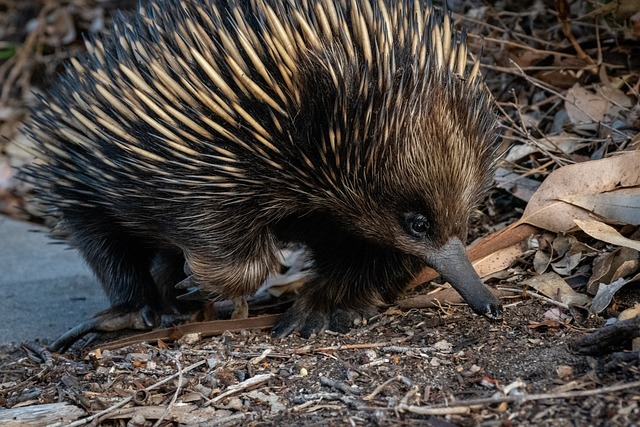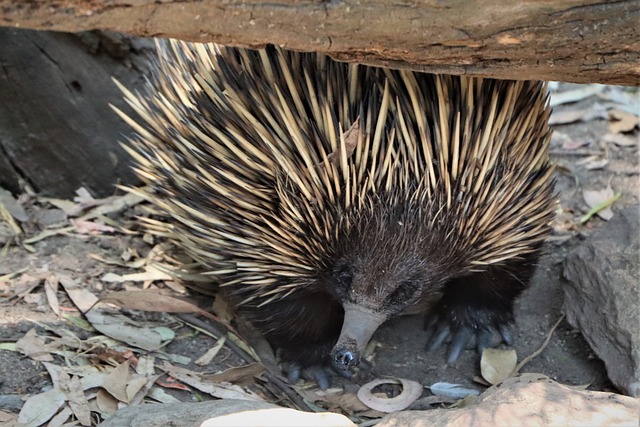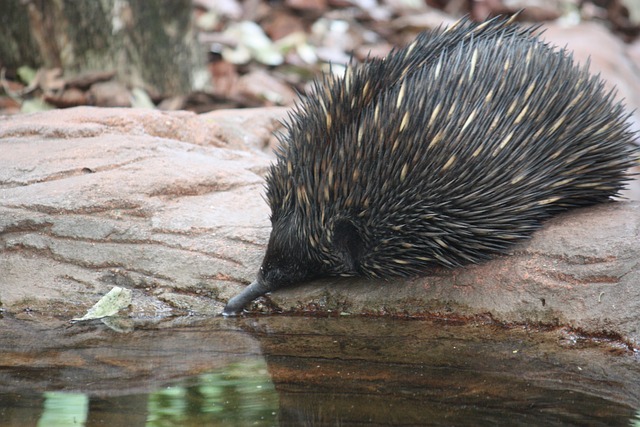Welcome to the fascinating world of the Echidna – a truly unique and remarkable mammal. This egg-laying creature has captured the curiosity of scientists and nature enthusiasts alike with its unusual characteristics and evolutionary significance.
Echidnas are found in various habitats across Australia and New Guinea, and their presence has sparked many questions about their origins and adaptations.
In this article, we will delve into the rich history and intriguing features of the Echidna, shedding light on its significant role in the study of mammalian evolution.
So, let's take a closer look at this fascinating creature and discover what makes it so special.

Evolutionary History of Echidna
The Echidna, also known as the spiny anteater, is a remarkable egg-laying mammal that has captured the interest of scientists and nature enthusiasts alike. This unique creature is found in Australia and New Guinea, making it a fascinating part of the diverse and unique ecosystem of these regions. But what makes the Echidna truly remarkable is its evolutionary history and significance in the study of mammalian evolution.
The Echidna belongs to the order Monotremata, which also includes the equally unique platypus. These two species are the only surviving members of this ancient group, and their ancestors can be traced back to the Mesozoic Era, over 150 million years ago. This makes the Echidna one of the oldest mammalian species still in existence today.
One of the most interesting aspects of the Echidna's evolution is its close relationship to the platypus. While the two species may look very different, they share many similarities in terms of their reproductive and physical characteristics. This has led scientists to believe that they share a common ancestor, and that the Echidna and platypus diverged from this ancestor around 19 million years ago.
The Echidna has adapted to its environment in a number of ways, which have allowed it to survive for millions of years. One of its most distinctive features is its spiny coat, which is made up of modified hairs. These spines not only provide protection from predators, but also help with regulating body temperature and providing insulation. Additionally, the Echidna has strong forelimbs and claws, which are used for digging and finding food in the ground.
Apart from its physical adaptations, the Echidna also has unique reproductive strategies that have contributed to its success in surviving and evolving. Unlike most mammals, the Echidna lays eggs, making it one of only five known egg-laying mammal species in the world. This remarkable reproductive strategy is thought to be an adaptation to the harsh and unpredictable environments of Australia and New Guinea.
The eggs of the Echidna take around 10 days to hatch, and the young, known as puggles, are then kept in a pouch on the mother's belly for about three months. During this time, the mother provides the young with milk through specialized mammary glands, just like other mammals. This unique combination of egg-laying and lactation is a fascinating aspect of the Echidna's evolutionary history.
The survival of the Echidna is closely tied to the ecosystem it inhabits. As a natural predator of insects and other small invertebrates, the Echidna plays a crucial role in maintaining balance and biodiversity in its environment. Its digging behavior also helps with soil aeration and nutrient cycling, making it an important contributor to the overall health of the ecosystem.
However, the Echidna faces several threats to its survival, including habitat loss and climate change. As human development continues to encroach on its natural habitat, the Echidna's population has been declining in certain areas. To combat this, conservation efforts are being made to protect and preserve its habitat, as well as raising awareness about the importance of this unique species.
Physical Characteristics of Echidna
The Echidna, also known as spiny anteaters, are one of the most unique and fascinating creatures on the planet. This egg-laying mammal has a variety of physical features that set it apart from other animals and allow it to thrive in its environment.
One of the most notable physical characteristics of the Echidna is its spiny coat. These spines, which cover most of its body, serve as a defense mechanism against predators. When threatened, the Echidna will curl up into a ball, exposing only its spines, making it difficult for predators to attack. These spines are made of keratin, the same material that makes up human hair and nails, making them strong and durable.
In addition to its spines, the Echidna has a long snout that it uses for foraging. Its snout is filled with electroreceptors, which allow it to detect the electrical signals of its prey. This unique adaptation helps the Echidna locate food, even in dark or underground environments. Its snout is also equipped with a sticky tongue, which it uses to catch insects, its primary food source.
The Echidna's feet also have interesting adaptations that aid in its survival. Its front feet are equipped with sharp claws that help it dig for food and create burrows for shelter. Its hind feet have long, sturdy claws that are used for defense and climbing trees. The Echidna is one of the few mammals that can climb using its hind feet, making it a versatile and adaptable creature.
Another notable physical characteristic of the Echidna is its ability to regulate its body temperature. Unlike most mammals, the Echidna is unable to sweat, making it difficult to maintain a stable body temperature. To combat this, Echidnas have developed specialized sweat glands in their tongue, which they use to lick their bodies and cool down.
The Echidna's physical features also play a crucial role in reproduction. Female Echidnas have a unique reproductive system, with only two nipples and a single opening for both reproduction and elimination. The male Echidna has a four-headed penis, but only two of the heads are used for each mating session. This complex reproductive system is a fascinating aspect of the Echidna's physical characteristics.
Aside from its unique physical features, the Echidna's role in its ecosystem is also worth mentioning. As insectivores, Echidnas play an essential role in controlling insect populations. They also contribute to the soil's health by digging and aerating it while foraging for food.

Reproduction and Life Cycle
The reproduction and life cycle of the Echidna is truly remarkable and sets it apart from other mammals. As the only egg-laying mammal, the Echidna has a unique and fascinating reproductive strategy.
To start, let's dive into the process of egg-laying. Unlike most mammals, Echidnas do not give birth to live young. Instead, the female Echidna lays a single egg which is then incubated in a pouch on her abdomen. This pouch provides warmth and protection for the developing egg. It takes about 10 days for the egg to hatch, and the mother will continue to provide care for the young for several months.
One of the most interesting aspects of the Echidna's reproductive process is the use of a specialized breeding cycle. Echidnas only reproduce once a year, and the timing of this breeding cycle is dependent on environmental factors such as temperature and food availability. This allows the Echidna to ensure that their young are born during the most favorable conditions for survival.
Once the egg has hatched, the young Echidna, also known as a puggle, is born with soft, fur-like spines that will eventually harden into the characteristic spiky coat. The puggle will continue to develop in the pouch for another two to three months before emerging into the world.
The survival challenges for young Echidnas are significant. They are born blind and with undeveloped spines, making them vulnerable to predators. To protect themselves, the puggles will remain in the mother's pouch for up to a year, only emerging when they are fully developed and able to fend for themselves.
The reproductive strategy of the Echidna is not only fascinating, but it also serves an important purpose in their ecosystem. By only reproducing once a year, Echidnas help to maintain balance in their population, ensuring that resources are not depleted.
Furthermore, the slow reproductive rate of Echidnas means that they are highly vulnerable to threats such as habitat loss and climate change. With only one chance to reproduce each year, any disruptions to their environment can have a significant impact on their survival.
Conservation efforts are essential in protecting the Echidna and its unique reproductive cycle. These efforts focus on preserving their habitat and minimizing human-caused disturbances in their natural environment.
In addition to its role in maintaining balance in its ecosystem, the Echidna's reproductive strategy also holds significant scientific value. Studying the reproductive cycle of the Echidna can provide insight into the evolution and adaptation of egg-laying mammals. Furthermore, research on the breeding cycle can also aid in understanding the effects of climate change on reproductive patterns in other species.
Echidna's Diet and Foraging Behavior
Echidnas, also known as spiny anteaters, are fascinating creatures with unique physical characteristics and behaviors. They are one of only two species of egg-laying mammals, the other being the platypus. Echidnas are found in Australia and New Guinea, and their diet and foraging behavior play a vital role in their survival and the balance of their ecosystem.
Diet:
Echidnas are primarily insectivores, meaning that their diet consists mostly of insects. However, they are also known to consume other small creatures such as worms, spiders, and even small lizards. They do not have teeth, so they use their long, sticky tongue to catch and consume their prey. Their diet varies depending on the season and availability of food, but they can consume up to 20,000 ants and termites in a single day.
Foraging Habits:
Echidnas are solitary animals, and they spend most of their time foraging for food. They are active during the day and have a unique foraging behavior known as “sniffing and digging.” Using their strong front claws, they dig into the ground and use their long snouts to sniff out their prey. They have a keen sense of smell, which helps them locate their food, especially hidden insects and larvae.
Adaptations:
Echidnas have several adaptations that allow them to survive in their environment and obtain their food. Their long, sharp claws are essential for digging and tearing apart termite mounds and ant nests. They also have a specialized tongue with backward-facing spines that help them catch and trap insects. Their long snout and keen sense of smell also aid in their foraging habits.
Importance in the Ecosystem:
Echidnas play a crucial role in maintaining the balance of their ecosystem. As insectivores, they help control the population of insects, preventing them from becoming pests. By digging through the soil, they also aerate it, allowing for better nutrient absorption and the growth of plants. In addition, their droppings contain undigested seeds, which contribute to seed dispersal and the growth of new plants.
Interesting Behaviors:
Echidnas have some interesting behaviors related to their diet. They have a low metabolism and a slow digestive system, so they can store food in their stomach for up to three weeks. This allows them to survive during times of food scarcity. They also have a unique way of regulating their body temperature. During hot weather, they will use their front legs to scrape the dirt and create a shallow burrow to cool down. In colder weather, they will dig a deeper burrow to keep warm.

Distribution and Threats to Echidna
The Echidna, also known as the spiny anteater, is a fascinating mammal that can be found in various parts of the world, including Australia, New Guinea, and Tasmania. However, their distribution is not widespread, and they can be found in specific habitats within these regions. In Australia, they are mainly found in the eastern and southeastern parts, while in New Guinea, they are found in the mountainous regions. Their distribution is closely related to their habitat requirements, and they are commonly found in areas with well-drained soils and a good supply of food.
Despite their limited distribution, Echidnas are facing numerous threats to their survival, both natural and human-induced. One of the major threats is habitat loss and fragmentation, which is caused by human activities such as deforestation, urbanization, and agriculture. As their habitat is destroyed, Echidnas are forced to move to other areas, which may not be suitable for their survival. This can lead to a decline in their population and even local extinctions.
Climate change is another significant threat to the Echidna. As temperatures rise and weather patterns change, it can disrupt their breeding patterns, affect their food sources, and even lead to the loss of their habitat. This can have a severe impact on their survival, as they rely heavily on specific environmental conditions for breeding and survival.
In addition to these threats, Echidnas also face predation from introduced species, such as feral cats and foxes. These predators have had a significant impact on the population of Echidnas, as they are not adapted to defend themselves against these predators. As a result, they can easily become prey, leading to a decline in their numbers.
Furthermore, Echidnas are also affected by other human activities, such as roadkill and accidental trapping. As they are slow-moving animals, they are at high risk of being hit by vehicles when crossing roads. This has become a significant cause of mortality in some areas, particularly in urban and suburban regions. Accidental trapping, such as being caught in a fence or net, can also harm Echidnas and even result in death.
To ensure the survival of Echidnas, conservation efforts are crucial. The Australian government has listed them as a protected species, and efforts are being made to reduce threats to their survival. This includes measures such as creating wildlife corridors, educating the public on the importance of these animals, and implementing measures to reduce roadkill incidents. In addition, research is being conducted to better understand the distribution and population of Echidnas, as well as their behavior and ecology, to inform conservation efforts.
Echidna's Significance in Science
The Echidna may seem like an unusual and obscure mammal, but its significance in the scientific community cannot be overstated. This unique creature has played a crucial role in our understanding of evolution and ecology, and continues to be a valuable subject of study for researchers around the world.
One of the key reasons why Echidna is so important in science is its evolutionary history. As one of the few surviving monotremes (mammals that lay eggs), the Echidna is believed to have diverged from its closest relatives, the platypus, around 50 million years ago. This makes it a living link to the early stages of mammalian evolution and provides valuable insights into how these animals have adapted and evolved over time.
Echidna's unique physical characteristics also make it a significant subject of study. With its spiny coat, long snout, and specialized tongue for catching ants and termites, the Echidna has evolved a set of adaptations that allow it to thrive in its environment. This has made it a valuable model for understanding how animals adapt to their surroundings and the role these adaptations play in their survival.
In addition to its physical attributes, Echidna's remarkable reproductive strategy has also captured the attention of scientists. As one of the only mammals that lay eggs, the Echidna has a highly unusual reproductive process. Females lay a single, leathery egg and then carry it in a pouch for incubation, much like a kangaroo. This fascinating system has been the subject of numerous studies and has shed light on the evolution of reproductive strategies in mammals.
Moreover, studying the Echidna's diet and foraging behavior has provided valuable insights into its role in its ecosystem. As a major consumer of ants and termites, Echidna helps to control their populations and maintain balance in the environment. Its unique foraging techniques, such as using its sharp claws to dig for food, have also been a source of fascination for researchers.
Unfortunately, the Echidna's survival is threatened by various factors such as habitat loss, introduced predators, and climate change. This makes it even more crucial to understand and protect this amazing creature. Several conservation efforts are currently underway to protect Echidna's habitat and raise awareness about its importance in the ecosystem.
In recent years, numerous studies and discoveries involving Echidna have further highlighted its significance in the scientific community. For example, researchers have found that Echidna's spines may have antibacterial properties, potentially leading to the development of new antibiotics. Additionally, Echidna's immune system is being studied for its potential in treating diseases such as cancer.
